What is the average click-through rate (CTR) of a Google Ads ad? When people ask this question, it’s often because they want to evaluate the click-through rate of their own ads.
CTR = Clicks through rate => clicks rate
Unfortunately, too many advertisers are content to achieve an average click-through rate and leave it at that.
Here’s an article to help you maximize your click-through rate and triple your performance on the average Google CTR.
What is a good click-through rate (CTR) on Google?
This obviously depends a great deal on your industry, the competition and your objectives. However, marketers who settle for 2-5% CTR are not up to the job.
We can’t see our competitors’ data, so we don’t know if their CTRs are similar to ours.
What we do know, however, is that whether or not our CTRs are “good” depends largely on the position of our ad. Ads in higher positions naturally have higher CTRs than those in lower positions.
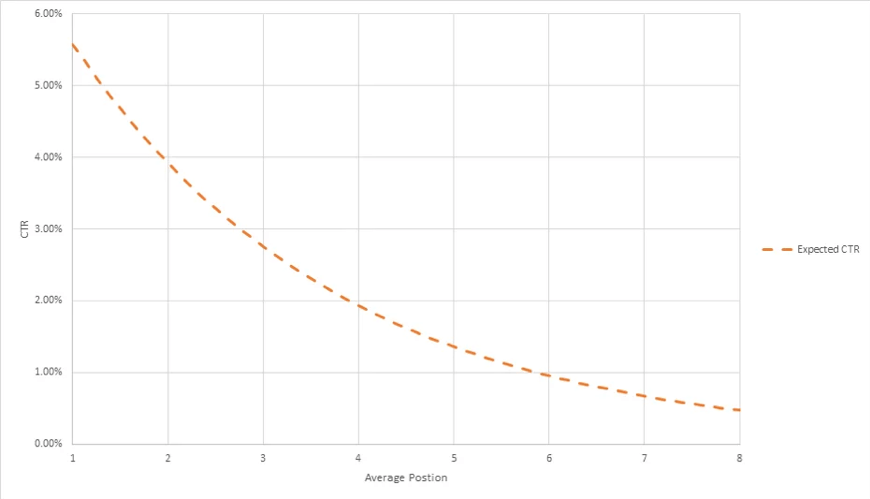
The chart above reflects average CTRs per ad position on Google, based on an analysis of nearly 100,000 advertiser accounts representing $3 billion in annualized spend. This gives a pretty good idea of the big picture when it comes to the CTRs that real advertisers are actually experiencing.
So the ad in second place has an average click-through rate of 4%. You might think that’s good, but it’s just an average. So if that’s what you’re seeing in your account, you’ve got plenty of room for improvement.
Averages are fine, but there’s still a lot of variability between advertisers, as you can see in the graph below. Remember, these are not keywords – each blue dot indicates an advertiser account.
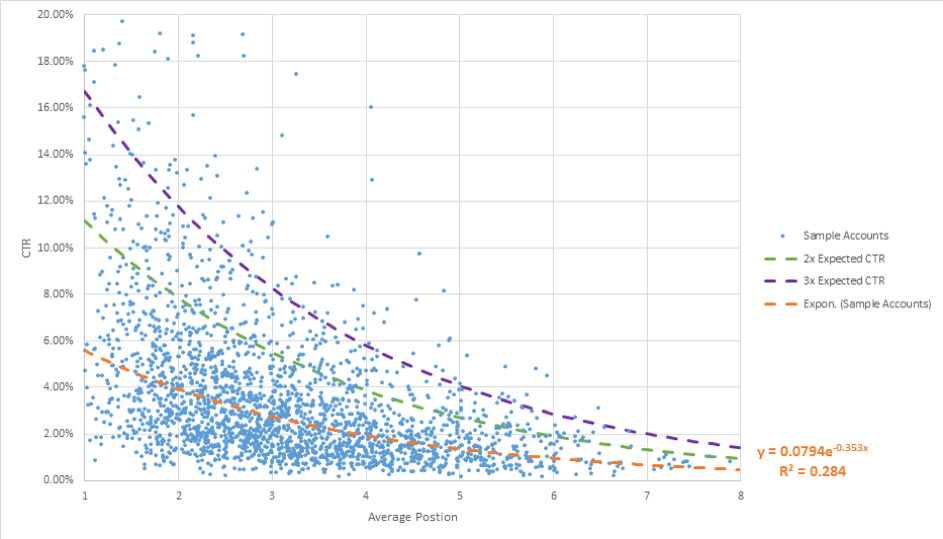
In this chart, you can see the expected or average CTR curve in orange, while the green and purple curves show what you need to aim for if you want to achieve CTRs two to three times higher than average.
This data shows us that there are indeed a few accounts that stand out and far outstrip their competitors. What does it take to be one of these exceptional advertisers?
The bottom 50% of advertisers achieve average or lower CTRs. If you want to be among the top 15% in the highly competitive Google Ads landscape, you need to achieve an average CTR on your account that’s twice the average (we call these advertisers “awesome”). If you achieve a CTR three times the average, you become a super-awesome advertiser, which is the case for about 1 in 20 advertisers.
You can quickly check whether your own CTR is above or below the average for your sector.
But why not aim for the stars? If you want to be in the top 1%, you need to achieve an average CTR six times the norm – we call these advertisers “Unicorns”. They’re rare, but I promise you that Google Ads unicorns do exist. They’re not inherently better than you; they just work harder and optimize their campaigns better.

So how do these unicorns do it? First, we need to understand…
The importance of quality scores and how Google Ads works
Understanding how AdWords auctions work is essential if you want to optimize and improve your performance.
Google ads are live auctions. Google must determine the ranking position of each ad, as well as the cost of each click, in real time for each ad in the auction.
Google uses ad ranking to determine your position in the auction and your CPC. The latter is calculated by multiplying the maximum cost-per-click bid (the maximum you’re willing to pay for a click) by your Quality Score (Google’s assessment of the quality of your ads).
Note: Google has recently updated Ad Rank to include the expected performance of ad extensions, but the basic principle remains the same.
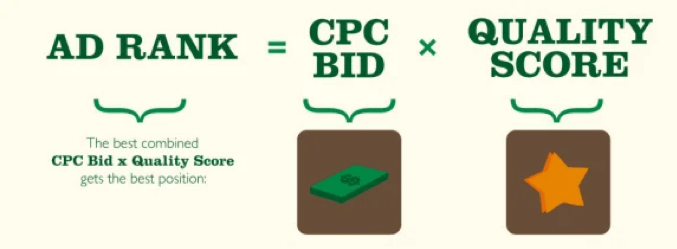
In this example, you can see exactly how Quality Score can affect your performance in this live auction.
The main advertiser, who obtained the first position, had a maximum bid that was $2 lower than that of his competitor, but his Quality Score and therefore his ranking were much higher, enabling him to obtain a better position and a lower CPC :
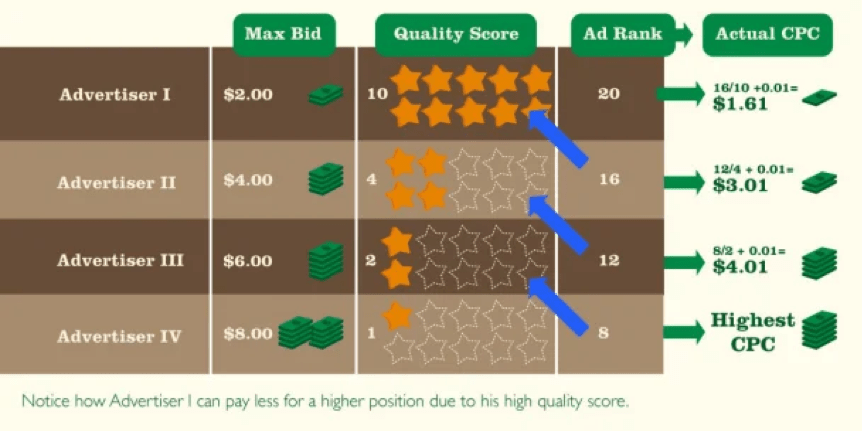
Google does this because it doesn’t get paid if no one clicks on its ads, so it prioritizes the ads most likely to succeed.
The average Quality Score is around 5.1 out of 10.
If you have an above-average Quality Score, you can get up to 50% off your cost per click. Conversely, if you have a below-average Quality Score, you can pay up to 400% more.
But CPC is only one measure among many. What about the actual cost per conversion? Here, we’ve also seen an inverse relationship, across billions of dollars of ad spend, whereby as your Quality Score increases, your cost per conversion decreases, because your clicks are so much cheaper.
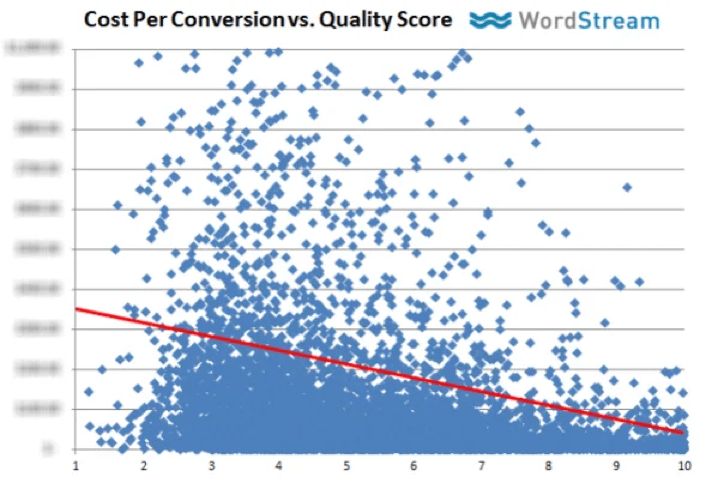
How is Quality Score calculated? In general, the higher your CTR, the higher your Quality Score. However, as you can see from the chart below, there’s a lot of variance, thanks to ad positioning.
As we saw earlier, ads at the top of the page are predisposed to getting more clicks than those further down.
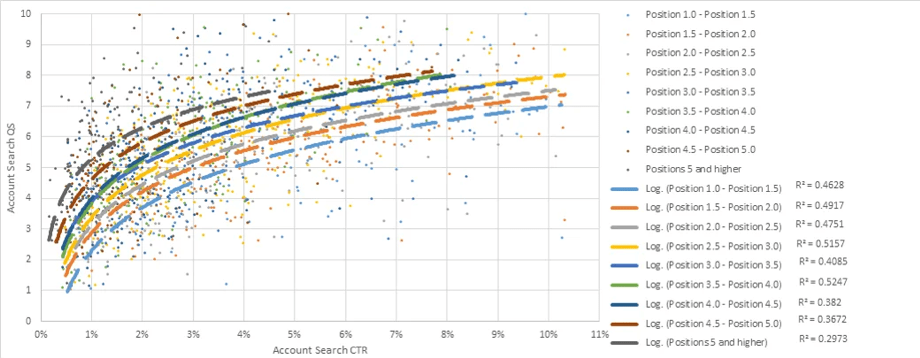
The blue line at the bottom, for example, refers to keywords in positions 1.0 to 1.5. Quality Score is not calculated solely on the basis of your CTR, but on the basis of your over- or under-performance in relation to the expected CTR.
In the following graph, you can clearly see how important your CTRs are in calculating your Quality Score.
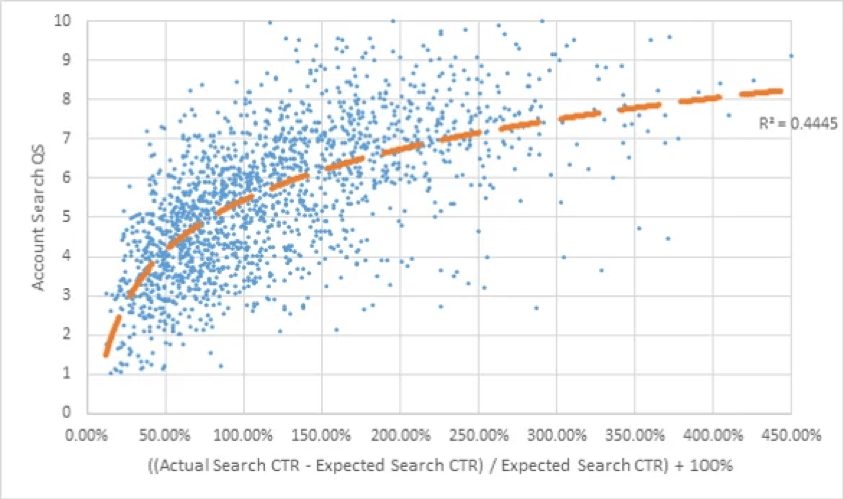
It’s all relative.
Your Quality Score, which is the key to getting prominent ad placements and low CPCs and CPAs, isn’t entirely based on your CTR. Rather, your ads and keywords must be above the expected average. This is the key to a high Quality Score.
What about these unicorns?
We’ve seen so far that an above-average CTR will help you achieve your goals, but to be better, you need more.
When we see “unicorn” accounts in the AdWords Performance Grader, they share some common characteristics:
– Every keyword in their account has a high Quality Score.
– They make effective use of negative keywords to reduce unnecessary expenditure.
– Their high impression share shows that Google loves to show their ads.
– They have very high, impressive double-digit CTRs, several times higher than the average.
– They target very specific, long-range keyword phrases.
– Their account activity is high – they continue to optimize and improve all the time.
If you can focus on ad and keyword combinations that have these above-average CTRs, the rewards are enormous: higher impression shares, higher ad positions, lower costs per click and lower conversions.

The unicorn hunt
By now you know what Google Ads unicorns look like, and you should have a good idea of why they’re so desirable. Let’s take a look at each of these features so you can replicate this success on your own account.
Unicorn keyword strategy
The top 1% of all Google Ads accounts tend to focus on keywords with strong commercial intent. This is not surprising, as people tend to click more when they are already motivated and intend to buy. For example, “best Internet marketing software” or “stainless steel dishwasher” are keyword phrases that demonstrate buying intent.
Branded keywords are another fantastic opportunity for advertisers, but we’re not just talking about your own brand. Target partner brands, competitor brands or other brands that your target market might be looking for when they’re in buying mode.
A third type of keyword that performs well are local keywords, where the searcher’s intention is to find your business – or your competitor’s (for example, “San Diego personal trainer”). These words tend to get high click-through rates, as local searchers often have strong commercial intent.
Avoid informative keywords wherever possible. These are often formulated as questions, such as “What is a dishwasher?” or “Where is Paris?”. These searchers tend to look for Wikipedia-type information and have no intention of buying, which can result in a lower CTR or unnecessary spend.
Warning about dynamic keyword insertion
If you want to achieve unicorn status, don’t overuse dynamic keyword insertion, or DKI. This is a strategy that consists of using a certain syntax in your ads to allow Google to automatically substitute the keyword that triggered the ad in the ad’s text or title.
Dynamic keyword insertion is beneficial, but only up to a point, as illustrated below:
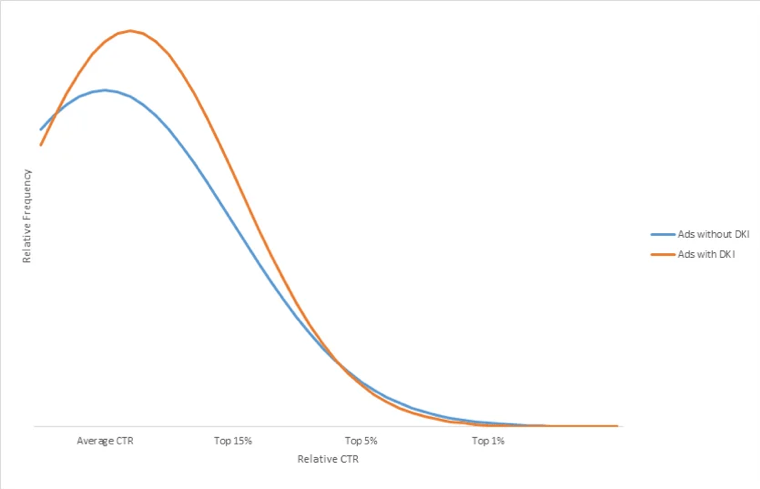
Here we have two curves: the red curve corresponds to ads with DKI and the blue to those without. The red curve shows that ads with DKI are relatively more abundant in the top 15%. However, as you move into the top 5% of ads, down to the unicorn ads, you’ll notice that the red curve drops below the blue curve.
Dynamic keyword insertion ads seem to hit a wall. This tells us that they should certainly be part of your toolbox, as they tend to produce slightly higher initial returns, but don’t put too much faith in them.
Ad extensions – are they the miracle solution?
Google seems to release new ad extensions almost every week, but what impact does using ad extensions have on ad Quality Score and will it help you become a unicorn?
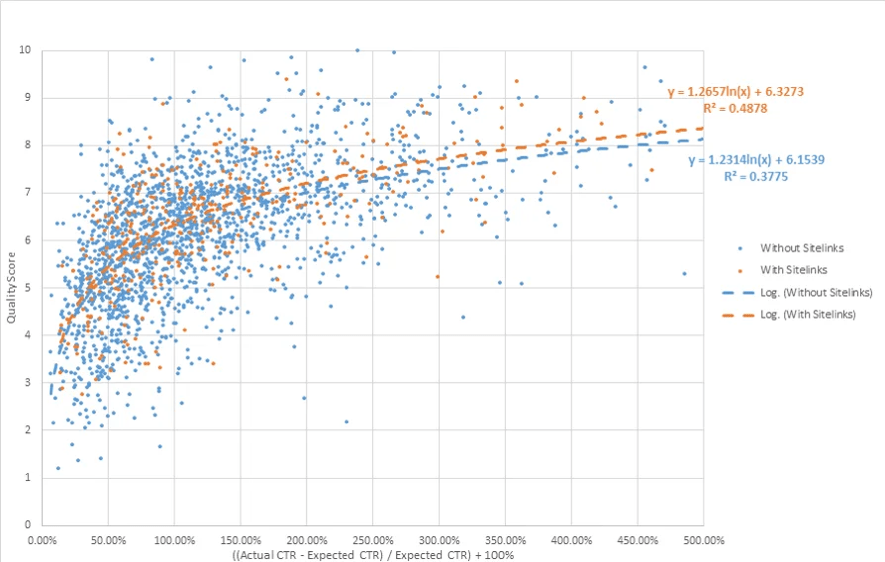
This graph shows that impact, and it’s not a game-changer. We can see that accounts that used sitelinks on their ads did slightly better than those that didn’t, which is no surprise.
Extensions can increase CTR, but they won’t fix boring text. It’s a modest increase, but it won’t double or triple your CTR rates.
Most ads suck. Create emotional ads.
Additional tip: Optimizing mobile ads
Our research has shown that calls from mobile ads convert 3 times more than clicks to a website. When testing mobile ads, you should base your conclusions on call rates, not CTR or conversion rates.
I’ll say it again: focus on call rates and do everything you can to get people to click on the “click to call” button.
What to remember about CTR optimization?
Deleting the bottom third of your account could be a good idea: your low CTR, low impression share and poor performing keywords. The idea here is to maximize the budget you’re currently spending on useless ads.
As you can see here, the average cost per click can be significantly lower in a number of areas of the Google Display Network than in Google Search.
Similarly, conversion rates for display ads are comparable to those for search ads, especially when using remarketing. In some sectors, such as automotive and travel, conversion rates for display ads can be even higher.
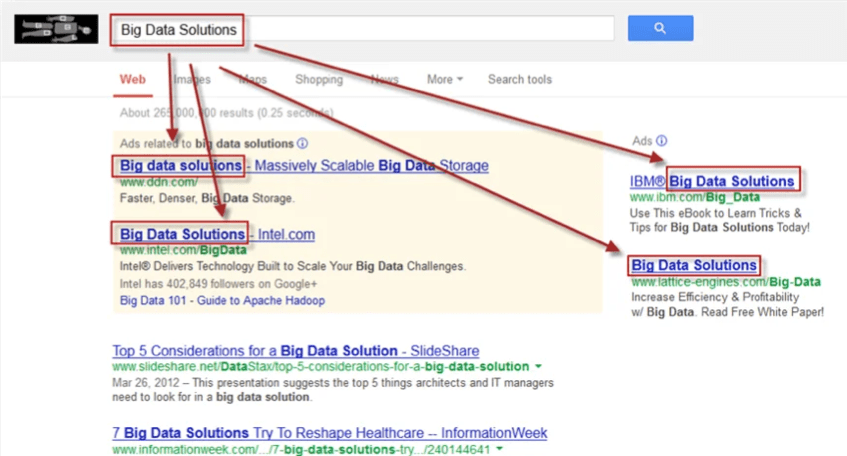
Many search results pages look like this, with boring ads that all look the same. That’s exactly why position can make such a difference, because the only differentiating factor is where an ad appears on the page.
This is a huge opportunity for you.
When you see a bunch of boring, dry, similar ads appearing for a query, you have a chance to stand out and be different. I like to call this the “Google ad jackpot”. The alternative is to find something that stands out from the crowd, that uses emotional triggers.
Create emotionally-charged ads with Swiss army knife brainstorming.
Respected marketer Perry Marshall has devised a structured brainstorming method for creating compelling advertising copy, called the “Swiss Army Knife”. You take different entities such as your customer, something your customer loves, something your customer hates, your customer’s best friend, your customer’s enemy and so on. You then determine how your brand connects or relates to each entity and build from there.
It’s a simple, structured brainstorming process that can help you generate more compelling and emotional ad copy to test, by blending these concepts, like this:

This is a perfect example of a unicorn ad, with a click-through rate of over 30%, that stands out from all the boring divorce lawyer ads.
Your ad copy needs to resonate on an emotional level, and it needs to be different to stand out. You need to test the important elements of your advertising message – things like your guarantee, your unique selling proposition and your offer.
Understanding relative abundance
Unicorns wouldn’t be so special if they were abundant. In fact, only one ad in 100 is a unicorn. The chances of finding it the first time are slim to none; on average, you have to try 100 different ads to find your unicorn.
The more ads you create and test, the more likely you are to come across one that beats the average by 2, 3 or even 6 times!
You don’t test as many ads as you think.
You may be thinking, “I already have THOUSANDS of ads on my account! The last thing I want to do is write more ads!”
That may be true, but I can almost guarantee that you’re not testing as many ads as you think. Certainly not all of them were created using the vision and process described above.
Let me tell you a secret: the bar, especially for SMBs, is incredibly low. The average small business Google Ads account has just 18 ads. You may not be able to reach 100 ads this month or even this year, but if you work at it and test even 40 or 50, you’re already doing much better than the majority of your competitors.
5% of ads account for 85% of impressions
Here’s more good news: you can get rid of your poorly performing ads, and there are plenty of them.
Across all accounts, we found that the top 5% of ads in an advertiser’s account accounted for 85% of their impressions.
You don’t need to test 100 ads for each ad group in your account.
Instead, choose your top two or three ad groups and concentrate your efforts there. Test them thoroughly, ideally reaching 100 ads to test in each of these top-performing groups.
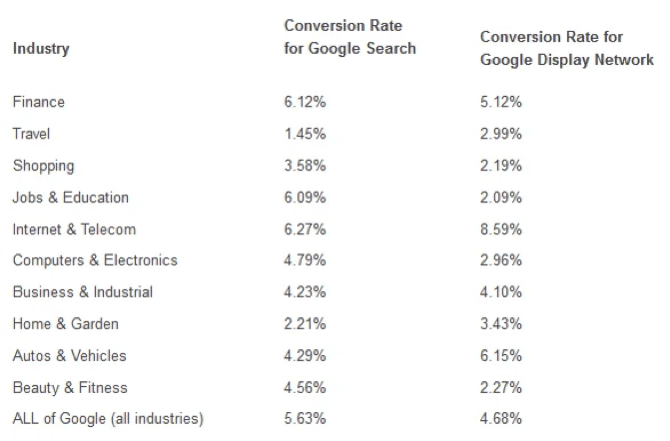
Of course, you can start by having us audit your Google Ads campaigns. This is an essential first step in determining the health of your Google Ads account and identifying optimization opportunities.
Want to know more?
Contact us – Adenlab, your Google Ads Agency



